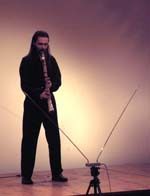contact
MOMus
Museum of Modern Art
Costakis Collection
21 st Kolokotroni Str.
Moni Lazariston
56430, Stavroupoli
Greece
| Theremin Classic Series | |
 |
Small series of analog THEREMINs, developed by Andrey Smirnov in 1998-2000. The theremin is an electronic musical instrument, invented by Russian inventor Leon Theremin in 1919, played by free movement of performer's hands in the space surrounding it. Movement of the right hand toward the right antenna controls pitch, while movement of the left hand toward the left antenna controls volume. |
| Digital Theremin | |
|
Digital Theremin is a project in progress initiated by Andrey Smirnov in 2005 during experiments with the theremin sensors based on the same principle as a well known electronic musical instrument the theremin. |
| T-Sensors | |
  |
The series of analog sensors, developed by Andrey Smirnov in 1999-2005, based on classical theremin heterodyning principle with a newly developed circuitry to produce super sensitive control. Different sorts of conductive medias could be connected to the sensor as an antenna: metal objects, foil, metal threads, all sorts of Christmas stuff etc.
|
| D-Sensors | |
 |
Most recent digital USB sensors, developed by Andrey Smirnov in 2005-2006, based on alternative "direct-drive" principle, could be used in different kinds of motion capturing systems, to monitor variations of air flow, mechanical vibrations, changes of electrical capacitance of different conductive medias etc. |
| Laser Monitoring | |
 |
Laser monitoring system, developed by Andrey Smirnov in 2004-2005, based on the similar principle to the famous "Buran" eavesdropping system, invented by Leon Theremin in 1945 for KGB. Theremin has used a radio-location system based on directed microwave radiation for monitoring the hidden acoustical vibrations of windows. The same principle was realized by means of recent laser technology. As a result, we can monitor and listen to inaudible vibrations in all kinds of reflecting media: membranes, liquids, solid objects, the water surface, bubbles, plastic bags, piano decks, wine glasses etc. to produce unusual feedbacks, cross-media interferences and interactions. Since we are not interested in any sort or hidden spying, we use visible light. It's a kind of sound/light alchemy, a play with materials and chemical processes. |
| Brain Wave Biofeedback System | |
 |
Brain wave biofeedback system, developed by Andrey Smirnov in 1985/2000. |
| Early Developments | |
 |
Selected hardware developments 1978-1990, including special computer hardware for biofeedback systems and psycho-physiological research, analog sound synthesis, analog and digital sound processing, including System-1 studio synthesizer (1980), Experimental Spatial Sound System, ADM-102, ADM-401 etc. digital delay lines, vocoders, MIDI-samplers, Percussion Sinthesizer, Drum-sampler, 10-seconds sampling delay line, wireless microphones, 16-bit Digital Multieffects Processor MEGAVERB etc. |
